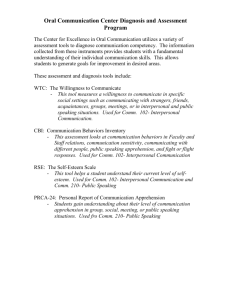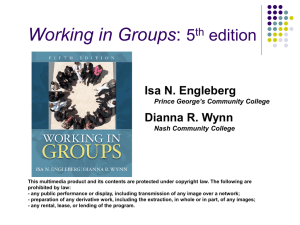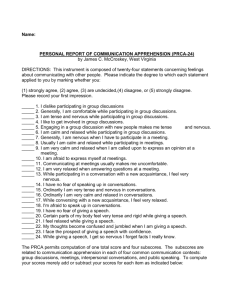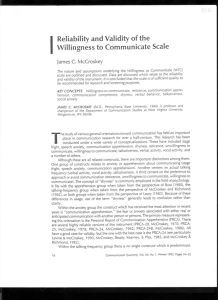The content validity of the
advertisement
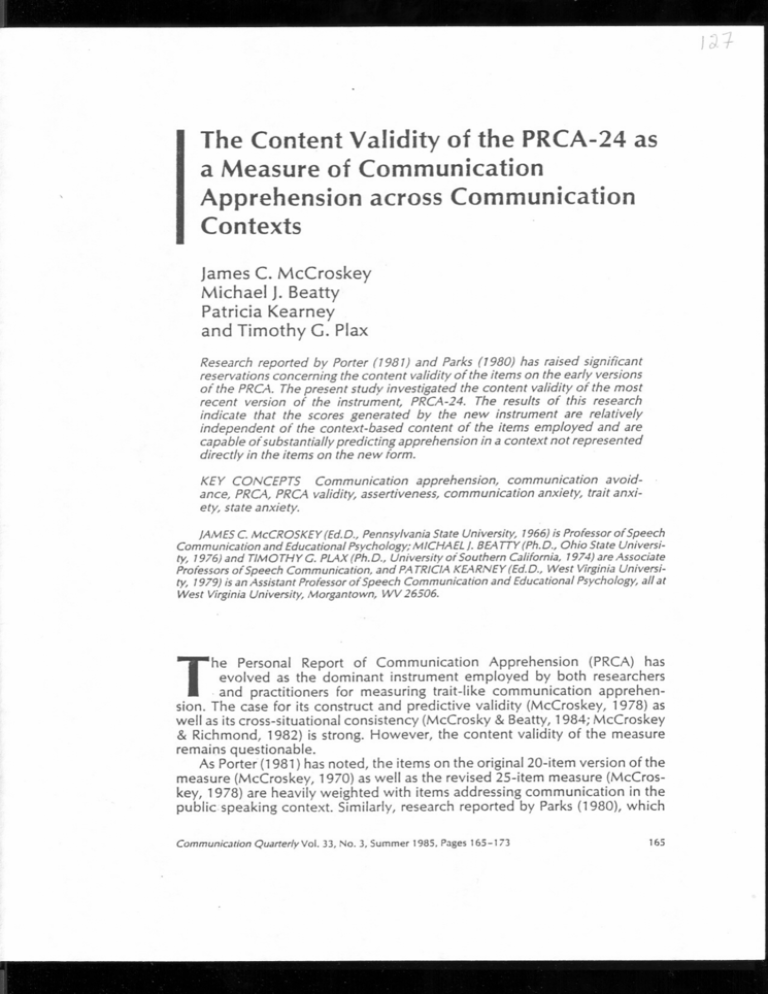
J;).1 The Content Validity of the PRCA-24 as a Measure of Communication Apprehension across Communication Contexts James C. McCroskey Michael J. Beatty Patricia Kearney and Timothy G. Plax Research reported by Porter (1981) and Parks (7980) has raised significant reservations concerning the content validity of the items on the early versions of the PRCA. The present study investigated the content validity of the most recent version of the instrument, PRCA-24. The results of this research indicate that the scores generated by the new instrument are relatively independent of the context-based content of the items employed and are capable of substantially predicting apprehension in a context not represented directly in the items on the new form. KEY CONCEPTS Communication apprehension, communication avoidance, PRCA, PRCA validity, assertiveness, communication anxiety, trait anxiety, state anxiety. JAMES C. McCROSKEY (Ed.D., Pennsylvania State University, 1966) is Professor of Speech Communication and Educational Psychology; MICHAEL j. BEA TTY (Ph.D., Ohio State University, 1976) and TIMOTHY G. PLAX (Ph.D., University of Southern California, 1974) are Associate Professors of Speech Communication, and PA TRICIA KEARNEY (Ed.D., West Virginia University, 1979) is an Assistant Professor of Speech Communication and Educational Psychology, all at West Virginia University, Morgantown, WV 26506. he Personal Report of Communication Apprehension (PRCA) has evolved as the dominant instrument employed by both researchers ,and practitioners for measuring trait-like communication apprehension. The case for its construct and predictive validity (McCroskey, 1978) as well as its cross-situational consistency (McCrosky & Beatty, 1984; McCroskey & Richmond, 1982) is strong. However, the content validity of the measure remains questionable. As Porter (1981) has noted, the items on the original 20-item version of the measure (McCroskey, 1970) as well as the revised 25-item measure (McCroskey, 1978) are heavilyweighted with items addressing communication in the public speaking context. Similarly, research reported by Parks (1980), which T Communication Quarterly Vol. 33, No.3, Summer 1985, Pages 165-173 165 employed an earlier version of the instrument, observed low correlations between PRCAscores and self-reported, anticipated state anxiety in a variety of low-threat interpersonal communication encounters. The results of these studies raise a question as to the representativeness and generalizability of the content of the items on the instrument as indicators of the broad-based, trait-like orientation which communication apprehension is presumed to be. At the time these criticisms of the PRCA were emerging, McCroskey was developing the most recent version of the instrument, the TABLE1 Personal Report of Communication Apprehension (PRCA-24) Directions: This instrument is composed of 24 statements concerning your feelings about communication with other people. Please indicate in the space provided the degree to which each statement applies to you by marking whether you (1) Strongly Agree, (2) Agree, (3) Are Undecided, (4) Disagree, or (5) Strongly Disagree with each statement. There are no right or wrong answers. Many of the statements are similar to other statements. Do not be concerned about this. Work quickly, just record your first impression. 1. Idislike participating in group discussions. 2. Generally, I am comfortable while participating in a group discussion. 3. Iam tense and nervous while participating in group discussions. 4. I like to get involved in group discussions. 5. Engagingin a group discussion with new people makes me tense and nervous. 6. I am calm and relaxed while participating in group discussions. 7. Generally, Iam nervous when I have to participate in a meeting. 8. Usually I am calm and relaxed while participating in meetings. 9. I am very calm and relaxed when I am called upon to express an opinion at a meeting. _10. I am afraid to express myself at meetings. _11. Communicating at meetings usually makes me uncomfortable. _12. I am very relaxed when answering questions at a meeting. _13. While participating in a conversation with a new acquantance, I feel very nervous. _14. I have no fear of speaking up in conversations. _15. Ordinarily I am very tense and nervous in conversations. _16. Ordinarily I am very calm and relaxed in conversations. _17. While conversing with a new acquaintance, I feel very relaxed. _18. I'm afraid to speak up in conversations. _19. I have no fear of giving a speech. _20. Certain parts of my body feel very tense and rigid while giving a speech. _21. I feel relaxed while giving a speech. _22. My thoughts become confused and jumbled when I am giving a speech. _23. I face the prospect of giving a speech with confidence. _24. While giving a speech I get so nervous, I forget facts I really know. SCORING: Group 18 - (1) + (2) (3) + (4) - (5) + (6) Meeting -- - - (i) + (8) + (9) - (10) - (11) + (12) 18 (13) + (14) (15) + (16) + (17) (18) 18 + (19) (20) + (21) (22) + (23) (24) 18 - --Group- + Meeting + Dyadic + Public Dyadic Public Overall CA Note. This instrument is copywritten by James C. McCroskey. Appropriate citation is: James c. McCroskey, An Introduction to Rhetorical Communication, 4th ed. (Englewood Cliffs, NJ: Prentice-Hall, 1982). The instrument may be reprinted and used for "research and instructional purposes without additional authorization or the copyright holder. Uses ror which there is expectation or profit, including publication or instruction outside the normal college or school environment, is prohibited without written permission of James C. McCroskey. 166 Communication Quarterly Summer 1985 PRCA-24 (McCroskey, 1982a; see Table 1). This instrument is based on the four comunication contexts suggested as most relevant to communication apprehension by McCroskey and Richmond (1980). Those contexts are public speaking, speaking in small groups, speaking in meetings, and speaking in dyads. Each context is represented by six items on the new version of the instrument. The contextual communication taxonomy advanced by McCroskey and Richmond (1980) was not presumed by them to be exhaustive. While the contexts they suggested, and upon which the PRCA-24was built, certainly are representative of common communication situations, they do not exhaust the types of contexts which could be delineated. Other contexts could be situations involving superior-suubordinate communication, situations involving intercultural encounters, situations involving interviews, and situations requiring assertiveness, just to name a few. Since the items on the new instrument do not request responses from all possible communication contexts, it is important to determine whether the items included provide a representative sample of items which correspond to the .largercommunication context domain to which the construct of trait-like communication apprehension is addressed. While recent conceptualization of communication apprehension draws a distinction between trait-like communication apprehension ana generalized-context communication apprehension (McCroskey, 1982b; 1984), the prevailing theory is that the former should substantially predict the latter. Thus, an appropriate measure of trait-like communication apprehension would be substantially correlated with dispositional (trait-like) measures of communication apprehension toward a variety of generalized contexts, such as public speaking, speaking in meetings, speaking in small groups, speaking in dyads, speaking in interviews, and most relevant to the present study, speaking in situations requiring assertiveness. It should be stressed that our concern in this research is with the association between across-contexts predispositions and within-context predispositions. Our focus is not on association between PRCA-24 scores with individuals' specific responses to a single communication encounter. While this is a critical concern for questions of predictive validity and crosssituational consistency, our concern is with the content validity of the items chosen for inclusion in the PRCA-24 instrument. That is, we are interested in the association between PRCA-24 scores and scores on a similar predispositional measure based on multiple responses across a broad range of situations. Thus, the first specific hypothesis we tested in this study was: HI: Scores on the PRCA-24will be substantially correlated with scores on a predispositional measure of communication apprehension concerning a generalized communicationcontext for which no items are included on the PRCA-24.Summer 1985 While any confirmationof our firsthypothesis would provide meaningful> support for the arguement for content validity of the items on the PRCA-24, it is also important to consider the magnitude of any relationship observed. While any statistically significant correlation obtained in a test of HI would provide a modicum for content validity, the higher the correlation obtained, Communication Quarterly Summer 1985 167 the stronger that support would be. The strongest support would be evidenced by a relationship between PRCA-24 scores and a predispositional measure for a context for which no items are included on the PRCA-24 measure of communication apprehension which did not differ significantly from similar scores for contexts which are represented by items on the measure. Therefore, our second hypothesis was: H2: Correlations between PRCA-24 scores and scores on predispositional mea- sures of communication apprehension for which representative items are included on the PRCA-24 will not differ significantly from correlations between PRCA-24scores and scores on a predispositional measure of communication apprehension for which no representative items are included on the PRCA-24.Summer1985 The communication context selected for testing our hypothesis was communication situations requiring assertiveness. The assertiveness context has received increased attention from communication researchers. Although assertiveness originated as a fairly nebulous phenomenon with no clear conceptual boundaries in early summaries of clinical experiences (Salter, 1949; vVolpe, 1958, 1969, 1970; Wolpe & Lazarus, 1966), it is clear that the definition of assertiveness emphasized the underlying influence of anxiety. However, behavioral aspects of the construct were a/so recognized (e.g., Lazarus, 1966; Fensterheim, 1971; Serber, 1972). Realizing that assertiveness occurs within a communication context, Norton and Warnick (1976) have summarized assertive communication behaviors as including "refusal of unreasonable requests, initiation of requests, insistence on fair treatment of self, spontaneous expression of one's feelings, outgoingness and willingness to take the initiative in social situations, and active (as opposed to passive) disagreement" (pp. 62-63). More recent research indicates that assertiveness is communicated both verbally (Rose &Tryon, 1979) and nonverbally (McFall, Winnett, Bordewick, & Bornstein, 1982). The influence of both anxiety and behavioral components of assertiveness are evidenced in McCroskey's (1981) analysis of CA's potential responses to those communication situations which demand assertiveness: "If it is difficult for high CA's to talk in situations which are not threatening to the average person, then it must be doubly difficult for them to speak out when assertiveness is required." Assertiveness provided three advantages leading to its selection as or criterion variable: 1) It is a dear, recognized communication context. 2) It is a context in which communication apprehension is highly likely to be stimulated.13) An individual's predisposition to be apprehensive in assertive communication situations is not directly assessed by the PRCA-24.No item on the instrument directly relates to this context. Method Participants Three hundred eleven undergraduates enrolled in introductory communication courses served as participants in the present study. The participants 168 Communication Quarterly Summer 1985 represented a diversity of majors with less than one percent being communication majors. To avoid sensitization to the issue of communication apprehension or assertiveness, the data were collected before material pertaining to either construct was presented in class. Measurement Communication Apprehension. The PRCA-24 (McCroskey, 1982a; see Table 1) was administered to all subjects. This instrument features six items, three positively and three negatively worded to avoid response bias, assessing subjects' apprehension in each of the four communication contexts discussed previously. Based on data drawn from over 25,000 college student subjects in 52 colleges and universities, the mean for the total score on the PRCA-24 is 65.60 with a standard deviation of 15.30. In the present data the mean and . standard deviation were 65.48 and 16.46, respectively. The alpha reliability for the scale was estimated to be .97, somewhat higher than the .93-.95 usually obtained. Assertiveness. The measure of assertiveness chosen for this study was the Rathus Assertiveness Schedule (RAS)(Rathus, 1973). While there are other acceptable measures of assertiveness, the RAS has been shown to have moderate to high test-retest (Rathus, 1973) and split-half reliability (Rathus, 1973; Norton & Warnick, 1976; Pearson, 1979). Moreover, the validity of RAS has been established by correlating RAS scores with independent raters' assessments of assertive others (Rathus, 1973); with other measurs of assertiveness (Norton & vVarnick, 1976); with nonverbal components of assertive behavior (McFall et a/., 1982) and trait and interpersonal anxiety (Orenstein, Orenstein, & Carr, 1975). Galassi & Galassi \(1978) conclude that the items contained on the RASinclude a wide range of situations involving assertiveness. Finally, the RASwas chosen because the items clearly reflect both anxiety and behavioral components of assertiveness. Some examples of the 30-item RASinclude: I will hesitate to make phone calls to business establishments and institutions; I would rather apply for a job or for admission to a college by writing letters than by going through with personal interviews; I find it embarrassing to return merchandise; I have avoided asking questions for fear of sounding stupid; and I have hesitated to make or accept dates because of shyness. Both the reliability and validity evidence as well as the consistency between the RASitems and the conceptualization of assertiveness advanced in this paper provided the rationale for the selection of the RAS.In the present study, the alpha reliability for the RASwas .91. Data Analysis The data analysis involved simple Pearson correlations. To test the first hypothesis, a correlation was computed between scores on the RASand total scores on the PRCA-24. To test the second hypothesis several additional scores were generated. First, the subscores on the PRCA-24were computed (see Table 1 for procedure). These were used as measures of generalizedCommunication Quarterly Summer 1985 169 TABLE2 Correlations Subscores among RAS, PRCA-24, PRCA-24 Partial Scores and PRCA-24 . RAS, PRCA, RAS and PRCA-24 Scores and PartialScores and PRCA-24 RAS PRCA-24 No Public No Meeting Subscores No Croup 1.00 .68 .69 .70 RAS .70 .97 .98 .98 PRCA-24 .70 1.00 .58 .78 .82 Public .52 .77 .87 .76 .88 .60 .88 Meeting .87 .73 .56 .86 .90 Group .61 .83 .80 .77 .78 Dyadic Note. Allcorrelationssignificant,p < .001. No Dyadic .66 .98 .82 .89 .86 .63 context communication apprehension in the four contexts represented. This procedure was chosen because it was believed to generate the highest possible correlations between the trait-like PRCA-24 score and the scores for each generalized context. Second, four partial PRCA-24 scores were obtained. Each partial score represented the omission of one of the four contexts included in the measure (e.g., No public = meeting + group + dyadic, etc.). Correlating each PRCA-24 subscore with the partial PRCA-24 score in which it was not included provided the most appropriate method of comparing these associations with the PRCA-24jRAS correlation. Results Obtained correlations are reported in Tables 2 and 3. As is noted in Table 2, the obtained correlation between PRCA-24 and RASwas .70. This correlation provides support for our first hypothesis. The PCRA-2~ could predict approximately half of the variance in the RASeven though no assertiveness items are included on the measure. The obtained correlations between PRCA-24 subscores and the total PRCA-24scores as well as the PRCA-24 partial scores are reported in Table 2. The correlations between the subscores and the total PRCA-24scores ranged from .77 (public) to .88 (meeting). The correlations between the subscores and the partial PRCA-24 scores which omitted that context ranged from .58 (public)to .76 (meeting).The RASjPRCA-24total score correlation (.70) was right in the middle of the correlations of the subscores with the partial PRCA-24 scores omitting their context. Public (.58) and dyadic (.63) were lower while group (.73) and meeting (.76) were higher.2 The correlationsbetween RASand the PRCA-24subscoresare reported in TABLE3 Correlations Among PRCA-24 Subscores Public Dyadic .40 Meeffng .61 Croup .50 Note.Allcorrelationssignificant,p < .0001. 170 Dyadic Meeting .57 .64 .69 CommUniGltion Quarterly Summer 1985 Table 2; and the intercorrelations among PRCA-24 subscores are reported in Table 3. The RASjPRCA-24 subscore correlations ranged from .52 (public) to .61 (dyadic). The PRCA-24 subscore correlations ranged from .40 (dyadicj public) to .69 (groupjmeeting). All of the RASjPRCA-24subscore correlations fell within the range established by the PRCA-24 subscore correlations. PRCA-24 subscores could predict from 16 to 48 percent of the variance in each other and could individually predict from 27 to 37 percent of the variance in RASscores. Although not designed to be of focal interest in this study, the obtained correlations (reported in Table 2) between the PRCA-24scores and the partial PRCA-24 scores ranged between .97 and .98. Thus, although the pairs of scores represented 75 percent item-duplication, each partial score could predict 94 to 96 percent of the variance in the total score. This suggests the total PRCA-24 scores have little dependence on any of the specific contexts included in the measure. Discussion The results of this research are strongly supportive of the content validity of the items employed in the PRCA-24. The first hypothesis was supported and the second (null) hypothesis could not be rejected even though very high power was available. The PRCA-24 was found to be highly predictive of scores on the Rathus (1972) measure of assertiveness. Although no items on the PRCA-24 directly address situations requiring assertiveness, the measure could predict almost half the variance in assertiveness scores. When these results are placed in context, the case for content validity is even stronger. The total PRCA-24 scores were more highly correlated with RAS scores than were two of the four partial PRCA-24, with the PRCA-24 subscores which were omitted from the partial score involved. Similarly, exactly half of the correlations between the RASand the PRCA-24subscores were higher and half were lower than the respective subscores' correlations with each other. The incidental observation that the individual subscores representing presumably distinct communication contexts contribute little unique variance no more than 4-6 percent) to the PRCA-24 total scores is highly suggestive that the items on the measure are tapping a generalized, trait-like response to communication. This, of course, is consistent with the theoretical framework upon which the instrument was based. In conjunction with the main results of this study concerning the ability of the PRCA-24 to predict apprehension in a context not included in the content of items on the measure (namely, assertiveness), these findings provide substantial support for the argument for content validity of the items included on the instrument. NOTES IThis criterion is particularly important. Parks (1980), although using an earlier version of the PRCA, found that the instrument did not correlate highly with other self-reports of anxiety experienced in low threat communication contexts (such as asking someone for the time). As McCroskey (1983) noted in his Communication Quarterly Summer 1985 171 critique of i"'arks'work, such results should be expected. If there is very little variance in the amount of anxiety people experience in a given type of communication setting, no substantial correlation with the PRCAis mathematically possible. Previous research, however, has demonstrated a high variability among people in response to assertive situations. Thus, ifthere were no substantial correlation between the PRCA and a measure of assertiveness, the content validity of the instrument as an index of a broad-based predisposition toward communication would be highly questionable. 2Because H2is a null hypthesis, a significant difference between the average subscore correlation with the partial PRCA-24scores and the RASjPRCA-24correlation would cause us to reject that hypothesis. This difference. however, was nonsignificant (z - .00, p > .05). . Thus, the power of the test is of critical concern. For this test. the power was above .99 for small effect size. We can, as a consequence be quite confident that our failure to reject this null hypothesis was not due to Type II error. In addition, since the RASjPRCA-24correlation was higher than two or the subscoresj partial PRCA-24score correlations and lower than the other two, it is questionable whether any statistical test is justified at all. Clearly, the null hypothesis cannot be rejected. REFERENCES Alberti, R.E.&Emmons, M.L.(1970). Yourpedect right:A guide to assertive behavior. San LuisObispo, CA: Impact. Fensterheim, H. (1971). Help without psychoanalysis. New York: Stein and Day. Fensterheim, H., &Baer, J. (1975). Don't say yes when you want to say no. New York:Dell Publishing Co. Galassi,M.D., & Galassi,J.P. (1978).Assertion:A criticalreview. Psychotherapy:Theory,Researchand Practice, 15, 16-28. Laszarus, A.A. (1966). Behavior rehearsal vs. non-directive therapy vs. advice in effecting behavior change.Behavior Research and Therapy,37, 269-277. McCroskey, J.e. (1978). Validityof the PRCAas an index qf oral communication apprehension. Communicaton Momographs, 45, 192-203. McCroskey, J.e. (1981, April). The relationships between assertivenes and communication apprehension. Paper presented at the annual meeting of the Eastern Communication Association, Pittsburgh, PA. McCroskey, J.e. (1982a).An introduction to rhetorical communication. 4th ed., Englewood Cliffs, NJ.: Prentice-Hall McCroskey, J.e. (1982b). Oral communication apprehension: A reconceptualization. In M. Burgoon (Ed.), CommunicationYearbook6 (pp. 136-170).BeverlyHills:Sage.Summer1985 McCroskey, J.e. (1983, February). Cross-situational consistency of the PRCA: Another view. Paper presented at the annual convention of the Western Speech Communication Association, Albuquerque, NM. McCroskey J.e. (1984). The communication apprehension perspective. In J.A. Daly & J.e. McCroskey (Eds.),Avoiding communication: Shyness, reticence and communication apprehension (pp. 13-38). Beverly Hills:Sage. McCroskey, J.e., & Beatty, M.J. (1984). Communication apprehension and communication state anxiety experiences: A research note. Communication Monographs, 51, 79-84. McCroskey, J.e. & Richmond, V.P. (1980). The quiet ones: Communication apprehension and shyness. Dubuque: Gorsuch-Scarisbrick. McCroskey, J.e., & Richmond, V.P. (1982) Communication apprehension and shyness: Conceptual and operational distinctions. CentralStates Speech Journal, 33, 458-469. McFall, M.E., Winnett, R.L., Bordewick, M.e., & Bornstein, P.H. (1982). Nonverbal components in the communication of assertiveness. Behavior Modification, 6, 121-140. Norton, R., & Warnick, B. (1976). Assertiveness as a communication construct. Human Communication Research, 3, 62-66. Orenstein. H., Orenstein, 0., & Carr, J.E.(1975). Assertiveness and anxiety: A correlation study. journal of Behavior Therapy & Experimental Psychiatry, 6, 203-207. Parks, M.R.(1980). A test of the cross-situational consistency of communication apprehension. Communication Monographs, 47, 220-232. Pearson, J.e. (1979). A factor analytic study of the items in the Rathus assertiveness schedule and the . personalreport of communicationapprehension.PsychologicalReports,45,491-497. Porter, D.T. (1981). An empirical appraisal of the PRCAfor measuring oral communication apprehension. Human Communication Research, 8, 58-71. Rathus, S.A. (1972). An experimental investigation of assertive training in a group setting. journal of Behavior Therapy and Experimental Psychiatry, 3, 81-86. Rathus, S.A.(1973). A 3D-item schedule for assessing assertive behavior. Behavior Therapy, 4, 398-406. Rathus, S.A., & Nevid, J.5. (1977). Concurrent validity of the 30-item Assertiveness Schedule with a psychiatric population. Behavior Therapy, 8, 393-397.5ummer 1985 172 Communication Quarterly Summer 1985 Rose, Y.j., & Tryon, W.W. (1979). judgments of assertive behavior as a function of speech loudness, latency, content, gestures, inflection, and sex. Behavior Modification, 3, 112-123. Salter, A. (1949). Conditioned reflex therapy. New York:Creative Age Press. Serber, M. (1972). Teaching the nonverbal components of assertiveness training. Journal of Behavior Therapy & Experimental Psychiatry, 3, 179-183. Wolpe, j. (1958). Psychotherapy by reciprocal inhibition. Stanford, CA:Stanford University Press. Wolpe, j. (1969). The practice of behavior therapy. New York:Pergamon Press. Wolpe, j. (1970). The instigation of assertive behavior: Transcripts from two cases. Journal of Behavior Therapy and Experimental Psychiatry, T, 145-151. . Wolpe,j. &Lazarus,A. (1966).Behaviortherapytechniques.NewYork:PergamonPress.Summer1985 Communication Quarterly Summer 1985 173
